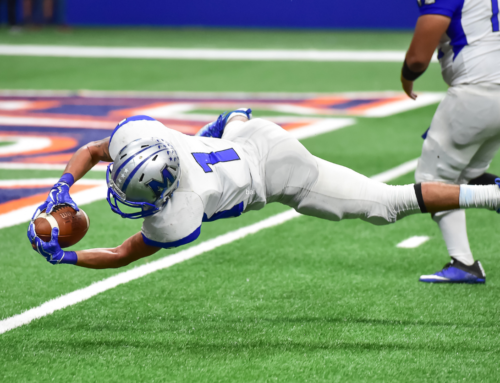The football recruiting pool is crowded, but you may have more choices than you think.
While the 5-star, top-ranked recruits get all the media attention on signing day, the majority of high school football players earn scholarships that aren’t reported on ESPN. In fact, there are far more teams, and more scholarship opportunities, in NCAA Division I FCS, Division II, and NAIA schools than in DI FBS. And as Tony Romo’s example shows, you don’t always have to land a scholarship at a major football power to excel in college football.
If your goal is to earn a scholarship to play football in college, the most important thing to know is which division is right for you. If you’re already getting interest from Division I college coaches, then you likely have a good chance of earning a full-ride scholarship at a DI school. If you’re hearing from lower-division schools, then your decision may get complicated. So, to help you find the right football division for you, consider the pros and cons of each level:
NCAA Division I FBS
The NCAA Division I Football Bowl Subdivision is big-time, glamorous college football and, for many, a stepping stone to the NFL. While the average roster of DI football teams is 122, each program is only allowed 85 athletes on scholarship at a time. And as a headcount sport, every DI FBS scholarship is a full-ride scholarship. That means, at any given time, roughly one-third of any DI FBS football team is comprised of non-scholarship athletes who, most often, are considered preferred walk-ons.
So, while most high school football players dream of earning a full-ride scholarship and playing for a legendary college football program such as Oklahoma, Clemson, or Alabama, remember there are trade-offs. Between August and December, playing on a DI football team can be a full-time job, leaving little time for studying, social activities, or enjoying college life. In addition, as you’re playing at the highest level, keeping yourself in shape, rehabbing an injury, or simply working to improve, can gobble up much of your free time. The point of all of the above is, if you have the skills and desire to pursue a DI FBS football scholarship, then, by all means, go for it. Just remember that a full-ride scholarship may ultimately mean a full-time job as a football player without much time to be a college student.
NCAA Division I FCS and Division II
If you’re not seeing much interest from DI FBS coaches, don’t worry, as there are more than twice as many NCAA Division I Football Championship Subdivision (FCS) and Division II football programs than there are in DI FBS. There’s still plenty of top-end football competition to be found in DI FCS and DII as well. And if you want to take your game to the next level after college, know that there were almost 200 former FCS or DII players on NFL rosters during the 2020 NFL season.
One caveat about FCS and DII programs is they’re both considered equivalency sports and therefore not every scholarship is required to be a full scholarship. In FCS, the scholarship limit is 63 while the average roster is 108 players. That means a coach can award partial scholarships in any combination to any and all of those 108 players, so long as the total amount of those partial scholarships doesn’t exceed 63. The same system applies in Division II, but there are only 36 scholarships available to be spread among an average roster of 113 players.
One other benefit to playing at FCS or DII programs is that football may not be a full-time job. Plus, you’ll likely be on a smaller campus, so you’ll have time to be both an athlete and a student and enjoy some or all of the same college experiences as other students.
NCAA Division III, NAIA, NJCAA, And Other Levels
The first thing to know about NCAA Division III football is that, while there are 249 schools fielding teams, none of them offer athletic scholarships. However, most DIII schools do have many academic scholarships available, so if you’re considering a Division III school, it’s important to keep your grades up. Plus, DIII schools offer what many consider the most ideal balance of academics and athletics, meaning you’ll have time to pursue football, academics, and campus life.
There are also scholarships available to play football at NAIA schools and junior colleges. Remember that, while the schools, budgets, and stadiums may be smaller, many football players have leveraged their play at an NAIA school or junior college into a scholarship at a Division I school and even as a stepping stone toward the NFL.
If you have the talent and desire, you can likely find a spot on a college football team and maybe even earn a scholarship to do so. It’s just a matter of taking the time to find the right school, and the right level of play, for you.
Did you enjoy the article ‘Which Football Division Is Right For You?’? If so, check out The Difference Between College Athletic Division Levels, or more of our articles HERE.




